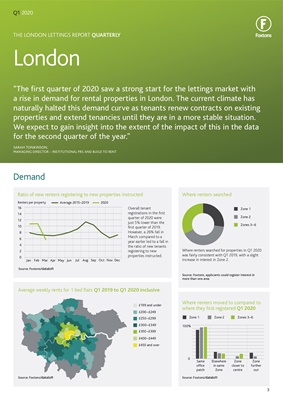
Compared to Q1 2019,
average rents in
Q1 2020 were higher
across most parts of
London, with strongest
growth in Zone 2.
£463
2.5%
Annual change
Weekly rent
Average weekly rent in London
Q1 2020
Change in average rents between
Q1 2019 and Q1 2020
Source: Foxtons/dataloft
All properties
5
£287 £395
£490 £681
-3.2% 6.2%
6.5% -1.7%
Annual change in average weekly rents Q1 2019 to Q1 2020
Average price per square foot in London
Average annual £psf for tenancies (long let)
Average £psf for sales exchanged
Rental premium /
discount by floor level
Source: Foxtons/dataloft
Source: Foxtons/dataloft
Zone 1 Zone 2 Zones 3-6 All London
5%
Average rents and annual change by property type
Average weekly rent
annual % change Q1 2019 to Q1 2020
Raised ground floor flats continued to achieve the
highest premiums in Q1 2020.
Source: Foxtons/dataloft, showing the rental premium/
discount paid per square foot compared to the overall
average rent per square foot for flats in Q1 2020.
1 bed flat
2 bed flat 3+ bed flat
THE LONDON LETTINGS REPORT QUARTERLY
Rental values
Average rents in the first quarter of the year continued to rise,
with one and two bed flats performing most strongly. Properties
in London's Zone 2 experienced the strongest growth, with
Zone 1 not far behind. 123+
£51.93
£967
£39.90
£728
£33.32
£715
£31.14
£685
£25.13
£518
Studio 1 bed flat 2 bed flat 3+ bed flat House
Rents
Sales
Lower ground
Ground
Raised ground
First floor and higher 3.0%
9.2%
-10.5%
5.7%
-2%
Studio
4
THE LONDON LETTINGS REPORT QUARTERLY
Supply / rents annual change
Throughout the first quarter, the number of properties available to
rent was lower than a year earlier. That said, new instructions rose
in March compared to March 2019, as landlords switched from
shorter term rentals and some tenants chose to end their tenancies.
This should be reflected in the availability figure next quarter.
-5%
21%
Annual change in rents and stock
Available stock / average rents Quarterly
Available stock / average rents
Source: Foxtons/dataloft
Source: Foxtons/dataloft
Chart shows the year-on-year change in both the number of properties available to rent (in the last month of the quarter,
i.e. Q1 2020 shows stock at the beginning of March) and the average price of properties let in the quarter.
30%
20%
10%
0%
-10%
-20%
-30% Available stock
Available stock
Average rental price
Average rental price
Jan 2016
Feb 2016
Mar 2016
Apr 2016
May 2016
Jun 2016
Jul 2106
Aug 2016
Sep 2016
Oct 2016
Nov 2016
Dec 2016
Jan 2017
Feb 2017
Mar 2017
Apr 2017
May 2017
Jun 2017
Jul 2017
Aug 2017
Sep 2017
Oct 2017
Nov 2017
Dec 2017
Jan 2018
Feb 2018
Mar 2018
Apr 2018
May 2018
Jun 2018
Jul 2018
Aug 2018
Sep 2018
Oct 2018
Nov 2018
Dec 2018
Jan 2019
Feb 2019
Mar 2019
Apr 2019
May 2019
June 2019
Jul 2019
Aug 2019
Sep 2019
Oct 2019
Nov 2019
Dec 2019
Jan 2020
Feb 2020
Mar 2020
-30% -30% -30%
30% 30% 30%
20% 20% 20%
10% 10% 10%
0% 0% 0%
-10% -10% -10%
-20% -20% -20%
Q1 2016
Q2 2016
Q3 2016
Q4 2016
Q1 2017
Q2 2017
Q3 2017
Q4 2017
Q1 2018
Q2 2018
Q3 2018
Q4 2018
Q1 2019
Q2 2019
Q3 2019
Q4 2019
Q1 2020
Q1 2016
Q2 2016
Q3 2016
Q4 2016
Q1 2017
Q2 2017
Q3 2017
Q4 2017
Q1 2018
Q2 2018
Q3 2018
Q4 2018
Q1 2019
Q2 2019
Q3 2019
Q4 2019
Q1 2020
Q1 2016
Q2 2016
Q3 2016
Q4 2016
Q1 2017
Q2 2017
Q3 2017
Q4 2017
Q1 2018
Q2 2018
Q3 2018
Q4 2018
Q1 2019
Q2 2019
Q3 2019
Q4 2019
Q1 2020
Annual change
Zone 1 Zone 2 Zones 3-6
Q1 2020
With a 21% increase in
new instructions in
March 2020 compared
to March 2019, it is likely
that the rate of decline in
availability will ease in
the second quarter.
Decrease in demand
Q1 2020 compared to Q1 2019
Increase in new instructions in
March 2020 compared to March 2019
Q1 2020